By Beverley D’SilvaFeatures correspondent
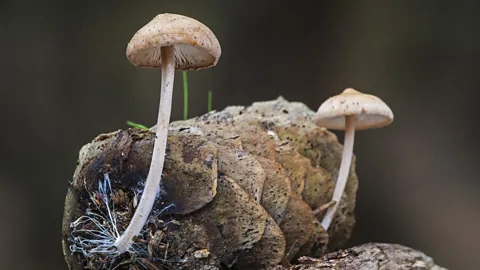 Getty Images
Getty ImagesFungi, cacti, pineapple and other ingenious solutions are helping to transform fashion. Here are seven of the most innovative, eco-friendly materials aiming to make a difference.
The fashion industry is famously bad news for the environment. Most of fashion’s impact on the planet happens while manufacturing, in the phase where fabric and materials are grown or made, then spun, dyed and finished into something we recognise as clothing. Leather production is a big part of that.
More like this:
– Can luxury fashion ever be sustainable?
– How Harris Reed became fashion’s superstar
– How to avoid buying new clothes
As the World Economic Forum puts it: “traditional leather production is a land-intensive process that produces large amounts of greenhouse gases”. The cattle industry releases roughly 14.5% of the world’s greenhouse gas emissions, including emissions from dairy cows and meat, with leather often coming from the latter. It also takes “dangerous chemicals to tan animal skin”, the WEF notes. Alternatives made from cacti, pineapple leaves and fungi could have a lower environmental impact.
London College of Fashion (LCF) launched its UAL Centre for Sustainable Fashion (CSF) ahead of the curve in 2008. Monica Buchan-Ng, its head of knowledge exchange, believes the biggest shift in the sustainable fabrics world is our awareness of them: “Brands and the public now have a better understanding of the impact materials have on people and the planet”.

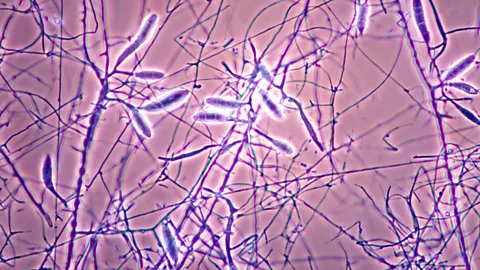 Getty Images
Getty ImagesHowever, she adds, “there is a tendency in fashion to conflate sustainable materials and sustainability. Sustainable materials can have an incredibly positive impact on the environment, drastically reducing use of energy, water, land or chemicals and pollution, and using waste – but they’re only part of the picture. Fashion must move away from an attitude of ‘doing less harm’ to one that is truly restorative.” She believes materials must sit within a sustainability picture that includes “prosperous livelihoods for fashion workers, contribution to vibrant cultures, positive benefits to nature and production within planetary boundaries”.
And what of “greenwashing” – described by Greenpeace UK as “a PR tactic used to make a company or product appear environmentally friendly, without meaningfully reducing its environmental impact”? This is covered by the “Green Claims Code” in the UK – legislation made in 2022 by the Competitions and Markets Authority – designed to make sure a business’s environmental claims comply with the law and will take action against offending firms.
Kimberly Nicholas, Lund University sustainability scientist, sums it up this way: “Planet Earth currently has a cow problem. Cows are the largest source of climate pollution and habitat destruction in agriculture. Wherever you can replace cows with plants or fungi, in food or textiles, it’s a big win for climate and biodiversity.” And it’s also down to consumers of fashion, she points out. “It’s beneficial for the fashion industry to shift to more efficient materials, but it’s also important for consumers to know that their most effective action is to consume less clothing. That means use the clothes you already have longer.”
There are several companies producing leather alternatives. Mirum, the first-known scalable, 100% plastic-free alternative to animal leather was created by the brand NFW or Natural Fiber Welding. It can be endlessly recycled, has been used by labels Allbirds and Pangaia, and invested in by Stella McCartney and Ralph Lauren. Pinatex – made from pineapple waste, has been adopted by brands from H&M to Hugo Boss. Vegea – made with grape waste from the wine industry, claims its production involves no toxic chemicals, heavy metals or other dangerous solvents, but is still 45% water-based – used by Calvin Klein, Ganni and Pangaia.

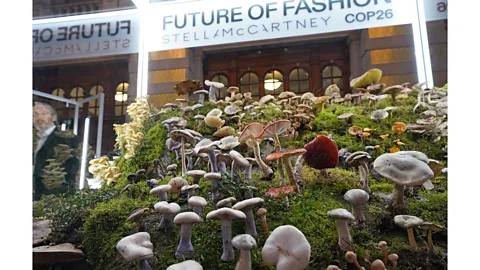 Getty Images
Getty ImagesOther notable materials are: Clarus, made by Natural Fiber Welding, and used by Ralph Lauren for its famous Polo shirt; Infinna, a premium cellulose fibre made from waste material and used by brands including Patagonia and Inditex (which owns Zara); and FLWRDWN, a patented, breathable and cruelty-free replacement for both animal and synthetic down, used by fashion brand Pangaia. These are just some of the new generation of creative biotech solutions being devised.
Here are seven of the most significant and innovative materials and creators – and hopes are high in the industry that they may help provide an eco-friendlier way forward for fashion.
1. Mylo
Mylo is a “solution in fungi”, a material that can justifiably claim to have started a “mushroom leather” revolution, claims its makers. It was created by scientists and engineers at Bolt Threads, a materials solutions company founded in 2009 and based in California. This sustainable leather is made from mycelium, a fungus’ root-like system that grows beneath the ground as filaments. Large sheets of fluffy foam are grown from fungal cells that are fed on waste sawdust, in a state-of-the art vertical farming facility powered by 100% renewable electricity.
They are then tanned in the same process as that applied to animal hides. Mylo is said to be nearly indistinguishable in look and feel when compared to traditional leather. The company’s brand partners include Stella McCartney – whose FraymeMylo bag was “the world’s first luxury handbag made from mycelium”; Adidas, which created its Stan Smith Mylo trainers; Lululemon, which used Mylo in its Concept yoga mat; Kering (owner of Gucci, YSL, Balenciaga); and Ganni – the Danish brand that committed to “phasing out virgin animal leather completely”. The company is also producing Microsilk, a vegan alternative to silkworm silk.

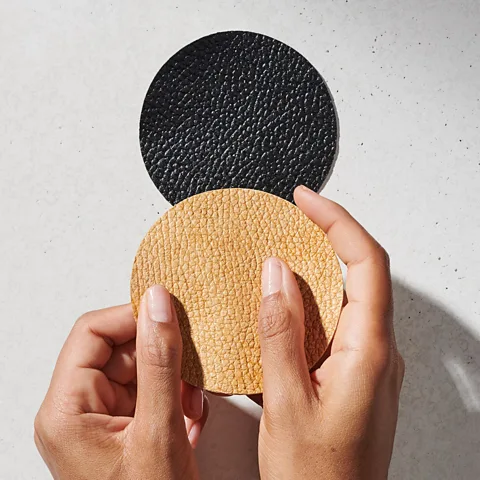 Bolt Threads
Bolt Threads2. Reishi
Reishi is a premium biomaterial made using Fine Mycelium, a patented technology developed by MycoWorks in California. Founded by artists – sculptor Phil Ross and dancer-poet Sophia Wang – it has, since 2013, “grown from the tiniest spore of an idea into a company that is now at the forefront of a potentially billion-dollar industry”, says Forbes. Ross spent decades in his laboratory-studio, working on blocks of mushroom material – the species Ganoderma lucid – as a “mycelium sculptor”. The world’s first Reishi product was a luxury hat collection by French-American designer Nick Fouquet. Three years later, MycoWorks launched a new mycelium leather – Sylvania – that has gone into producing Hermes travel bag range, the Victoria Voyage.
Reishi, though, is its flagship product and has the strength, durability and hand-feel of high-quality leathers but with lower environmental impact. It is tanned and finished by heritage tanneries in Europe, using chrome-free tanning and dying technologies. Wang says that the pair value “the ascetic rigour of making something beautiful, that performs well and is an object of desire”. She adds that fashion brands “appreciated that we are founded by artists as opposed to coming out of a lab”.
3. Vitrolabs
According to the San Franciso-based company Vitrolabs: “a single biopsy from this cow can make millions of handbags”. To create “the world’s first cultivated leather” VitroLabs take cells from a happy, healthy cow, and then they “reproduce the natural conditions that allow those skin cells to regenerate indefinitely”. Cells are grown in a nutrient-rich environment until they form a tissue with the same durable and luxurious properties as animal hides.
The company notes traditional leather manufacturing has a number of significant environmental impacts, which include greenhouse gases to pollutants from tanning. VitroLabs raised $46 million of funding in May 2022, with backing from Leonardo DiCaprio and Kering, and is “a game changer” according to Vogue.

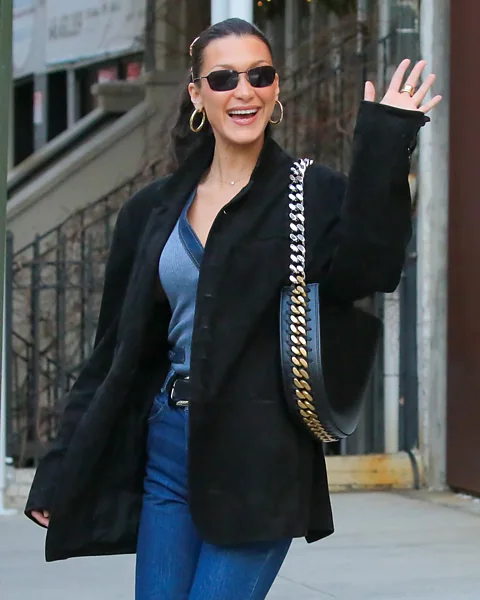 Getty Images
Getty Images4. Orange Fiber
The brand Orange Fiber has created a silky fabric made from cellulose that has been extracted from citrus peel which would otherwise be disposed of. Established in Catania in 2014, the company worked with Italy’s largest technical university (Polytechnic University of Milan) on the patented process. On Earth Day 2017, the first collection made exclusively of Orange Fiber was launched by Italian luxury fashion brand Salvatore Ferragamo; an outfit from this was shown in the V&A’s 2018 Fashion from Nature exhibition.
It has been used by H&M and Neapolitan tailoring brand E Marinella for its high-end sustainable ties and silk scarves. According to Orange Fiber co-founder Enrica Arena, the biggest challenges have been the industrial scale-up and optimisation of production costs, but they’re still aiming for all its products to be made of recycled or other sustainably sourced materials by 2030 (a guideline that already applies to 80% of materials they use). With Lenzing, Orange Fiber made the first Tencel-branded lyocell fibre made of orange and wood pulp.
5. Kintra
Created with sugar from corn and wheat, Kintra is a fully biodegradable alternative to polyester. Synthetic textiles account for more than 60% of textile fibres globally, and the microfibres they shed are toxic to wildlife (and endure for tens of thousands of years). Biodegradeable fabrics avoid contributing to the vast problem of long-lived microfibres in the oceans. Kintra is working in partnership with Pangaia, a direct-to-consumer materials science brand.
6. Circulose
Using 100% discarded clothes and renewable energy, Circulose made its debut on the catwalk in Paris in 2014 as a simple yellow dress made from old blue jeans. It’s from Stockholm company Re:newcell, one of the first industrial-scale companies to turn old clothes into new textiles using an eco-friendly chemical recycling process. The company’s textile recycling plant in Sundsvall, Sweden, can produce 60,000 tonnes of recycled fibres per year, and is the first clothes recycling facility of its kind. Re:newcell perfected and patented technology to shred and break down clothes into Circulose pulp, which is used to make biodegradable virgin quality viscose or lyocell textile fibres. “This is the link that has been missing to close the loop,” says a spokesperson. The company says it aims to reduce water, waste, microplastics and deforestation in its production process.

 Getty Images
Getty ImagesAccording to Nina Marenzi of The Sustainable Angle, which runs the Future Fabrics Expo in London: “They could be recycling one billion T-shirts a year by 2030.” In July 2020, Levi’s launched the Levi’s 502 Taper jeans, made from organic cotton and Circulose, and it’s the most sustainable model in the label’s history. H&M, Tommy Hilfiger, Cos and Ganni are using Circulose in their 2024 collections. Swedish designer Jade Cropper, whose work has been championed by Gigi Hadid and Kim Kardashian among others, partnered with Circulose for her spring/summer 2023 collection. Another company making waves in the recycled textiles area is NuCycl, linked to Stella McCartney and Adidas.
7. Aircarbon
“What if our materials could heal us?” is a teaser posed on AirCarbon’s website. This fabric is made using the greenhouse gas methane as an ingredient. The company says the plastic created is biodegradeable in nature. The company also says it is working on a way to break down AirCarbon back into methane, which could then theoretically be used to make more of the material again in a circular process. After many years working on how to scale up, Newlight Technologies has now released AirCarbon to the market via its two new brands – Covalent, a range of luxe eyewear and accessories, and Restore, its alternative to plastic utensils bought in by restaurant chain Shake Shack. AirCarbon contains no synthetic plastics or glues, and claims to be home-compostable and ocean-friendly. Nike is a partner, and the patented product has been verified plastic-free by Oceanic Global Blue Standard. Another carbon-negative material is LanzaTech, adopted by Zara and Lululemon.
If you liked this story, sign up for The Essential List newsletter – a handpicked selection of features, videos and can’t-miss news delivered to your inbox every Friday.
Credit: Source link